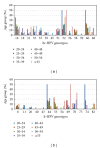HPV Type Distribution and Cervical Cytology among HIV-Positive Tanzanian and South African Women
- PMID: 22811925
- PMCID: PMC3394385
- DOI: 10.5402/2012/514146
HPV Type Distribution and Cervical Cytology among HIV-Positive Tanzanian and South African Women
Abstract
Background. There are limited data on high-risk human papillomavirus (hr-HPV) genotypes among HIV-positive women in Africa, and little is known about their relationship with cervical cytology in these populations. Methods. We conducted a cross-sectional study among 194 HIV-positive women (143 from Tanzania, and 51 from South Africa) to evaluate HPV genotypes among HIV-positive women with normal and abnormal cytology. Cervical samples were genotyped for HPV types, and slides were evaluated for atypical squamous cell changes according to the Bethesda classification system. Results. Prevalence of high grade squamous intraepithelial dysplasia (HSIL) was 9%. Overall, more than half (56%) of women were infected with an hr-HPV type; 94% of women with HSIL (n = 16), 90% of women with LSIL (n = 35), and 42% of women within normal limits (WNL) (n = 58) tested positive for hr-HPV. Overall, the most prevalent hr-HPV subtypes were HPV16 (26%) and HPV52 (30%). Regional differences in the prevalence of HPV18 and HPV35 were found. Conclusion. Regional differences in HPV genotypes among African women warrant the need to consider different monitoring programmes for cervical preneoplasia. HPV-based screening tests for cervical preneoplasia would be highly inefficient unless coupled with cytology screening of the HPV-positive sample, especially in HIV-positive women.
Figures



Similar articles
-
Prevalence and distribution of selected cervical human papillomavirus types in HIV infected and HIV uninfected women in South Africa, 1989-2021: A narrative review.S Afr J Infect Dis. 2022 Jun 8;37(1):363. doi: 10.4102/sajid.v37i1.363. eCollection 2022. S Afr J Infect Dis. 2022. PMID: 35815224 Free PMC article. Review.
-
The prevelance of human papillomavirus (HPV) genotypes detected by PCR in women with normal and abnormal cervico-vaginal cytology.Ginekol Pol. 2018;89(2):62-67. doi: 10.5603/GP.a2018.0011. Ginekol Pol. 2018. PMID: 29512809
-
HPV genotype distribution and anomalous association of HPV33 to cervical neoplastic lesions in San Luis Potosí, Mexico.Infect Agent Cancer. 2016 Mar 30;11:16. doi: 10.1186/s13027-016-0063-z. eCollection 2016. Infect Agent Cancer. 2016. PMID: 27030798 Free PMC article.
-
Performance of visual inspection with acetic acid and human papillomavirus testing for detection of high-grade cervical lesions in HIV positive and HIV negative Tanzanian women.Int J Cancer. 2014 Aug 15;135(4):896-904. doi: 10.1002/ijc.28712. Epub 2014 Feb 4. Int J Cancer. 2014. PMID: 24391021
-
Persistence and risk factors of high-risk human papillomavirus infection among HIV positive and HIV negative tanzanian women: a cohort study.Infect Agent Cancer. 2022 Jun 11;17(1):26. doi: 10.1186/s13027-022-00442-2. Infect Agent Cancer. 2022. PMID: 35690838 Free PMC article. Review.
Cited by
-
Prevalence and distribution of selected cervical human papillomavirus types in HIV infected and HIV uninfected women in South Africa, 1989-2021: A narrative review.S Afr J Infect Dis. 2022 Jun 8;37(1):363. doi: 10.4102/sajid.v37i1.363. eCollection 2022. S Afr J Infect Dis. 2022. PMID: 35815224 Free PMC article. Review.
-
Acceptability of self- collection for human papillomavirus detection in the Eastern Cape, South Africa.PLoS One. 2020 Nov 10;15(11):e0241781. doi: 10.1371/journal.pone.0241781. eCollection 2020. PLoS One. 2020. PMID: 33170891 Free PMC article.
-
Molecular Characterization of High-Risk Human Papillomavirus in Women in Bobo-Dioulasso, Burkina Faso.Biomed Res Int. 2016;2016:7092583. doi: 10.1155/2016/7092583. Epub 2016 Jul 20. Biomed Res Int. 2016. PMID: 27525275 Free PMC article.
-
Human papillomavirus prevalence and genotype distribution among HIV-infected women in Korea.J Korean Med Sci. 2014 Jan;29(1):32-7. doi: 10.3346/jkms.2014.29.1.32. Epub 2013 Dec 26. J Korean Med Sci. 2014. PMID: 24431902 Free PMC article.
-
Prevalence and Genotype Distribution of High-Risk Human Papillomavirus Infection Among Sub-Saharan African Women: A Systematic Review and Meta-Analysis.Front Public Health. 2022 Jul 8;10:890880. doi: 10.3389/fpubh.2022.890880. eCollection 2022. Front Public Health. 2022. PMID: 35875040 Free PMC article.
References
-
- Muñoz N, Xavier Bosch F, Castellsagué X, et al. Against which human papillomavirus types shall we vaccinate and screen? The international perspective. International Journal of Cancer. 2004;111(2):278–285. - PubMed
-
- De Sanjose S, Quint WGV, Alemany L, et al. Human papillomavirus genotype attribution in invasive cervical cancer: a retrospective cross-sectional worldwide study. The Lancet Oncology. 2010;11:1048–1056. - PubMed
-
- Dols JAM, Boon ME, Monachese M, et al. The impact of probiotic yogurt on HIV positive women in Tanzania. International Dairy Journal. 2011;21(8):575–577.
-
- Boon ME, Kok LP. Formalin cross-linking or optimized alcohol coagulation: that is the question. In: Pandalai SG, editor. Recent Research Development in Human Pathology. Kerala, India: Transworld Research Network; 2005. pp. 17–38.
-
- Dols JAM, Smit PW, Kort R, et al. Microarray-based identification of clinically relevant vaginal bacteria in relation to bacterial vaginosis. American Journal of Obstetrics & Gynecology. 2011;204:305.e1–305.e7. - PubMed
LinkOut - more resources
Full Text Sources
